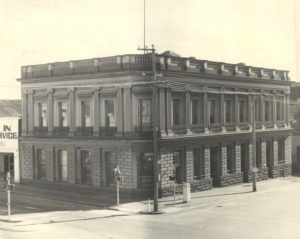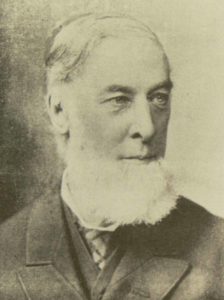
Cuthbert’s building, Lydiard Street, North, Ballarat
Cuthberts legal firm celebrates 150 years of legal practice in Ballarat with an art and memorabilia exhibition at the Ballarat Fine Art Gallery. More than 100 items of art and legal memorabilia will be on display from 20 August to 11 September 2005. The exhibition of artworks and memorabilia celebrates the association of Cuthberts and partners with the history of Ballarat. It includes beautifully crafted examples of legal documents and objects linked to the legal profession, as well as paintings and decorative arts purchased with bequest monies given to the Ballarat Fine Art Gallery (BFAG) by the Cuthbert and Must families. This exhibition also provides an opportunity to acknowledge the contributions Agar Wynne and John James McGowan made to the Gallery’s history.
Henry Cuthbert, a Protestant Irishman was admitted to the Four Courts in Dublin, Ireland in May 1854, the year of the Eureka uprising. The next year he was setting up his business in Ballarat, having been admitted to the Supreme Court of the Colony of Victoria in December 1854.
The Ballarat Times reported that Henry Cuthbert appeared in the case of McIntosh v Lockie in the Ballarat Mining Court in September 1855. Cuthbert apparently prompted the plaintiff during the hearing, which caused the newspapers to write a report, under the title ‘The Local Court and the Lawyers’, on the ‘gentleman in black who stood at his [McIntosh’s] elbow’, and who was undoubtedly Cuthbert.
The paper reported: ‘The case before the court was that of McIntosh v Lockie and party, in which, while the plaintiff was the spokesman and cross-examiner. He was cautiously interrupted every now and then in the course of his address to the Court, and his elucidation of facts from the defendant, by sundry nods, nudges, and mysterious whispers from the gentleman in black who stood at his elbow’. Cuthbert vigorously defended himself in a letter to the editor of the Star newspaper.
Cuthbert acquired the services of a law clerk, Thomas Brereton Watson in January 1856. Henry’s diary shows that he worked hard appearing before both Buninyong and Ballarat Courts. On Tuesday 1 July 1856 he attended the Local Police Court on behalf of Mr Donaldson; on Saturday 5 July Cuthbert appeared in Buninyong for Mr Parker who was charged with stealing ₤18. The prisoner was discharged. Cuthbert received ₤10 in fees. On Wednesday 16 July he represented five clients at the Buninyong Court. He prepared a Deed of Partnership for Evan Rowlands and Robert Lewis of softdrink company fame, and drafted many other Bills of Sale, Powers of Attorney, investigation of Titles, and pursued Crown Grants, Deeds of Partition and approved mortgages.
In June 1857 Henry Cuthbert became involved with the establishment of the Ballaarat Gas Company and by November of the same year a Special Act of Parliament passed the Ballaarat Gas Company Incorporation Bill. Among Cuthbert’s other activities were Director of the Buninyong Gold Mining Company, Member of Legislative Council for the seat of South West Province, Victoria, Postmaster General for 1877, 1880, and 1897, Commissioner of Trade and Customs 1880, Chancellor of the Anglican Diocese of Ballarat 1883, Ex-Officio Member of Council for Ballaarat Fine Art Gallery Association 1884, Minister of Justice 1886, Delegate to the National Federation Convention held in Sydney in 1891, Solicitor General and Minister for Health 1894, KCMG awarded in 1897 for his contribution to politics and community. Sir Henry Cuthbert became the only solicitor in Victoria appointed a Queen’s Counsel in 1899, a distinction which he held for 95 years.
Cuthbert married Emma Hepburn nee Kirby in 1863 and commissioned Beaufort House in 1861 and the legal offices at 102 Lydiard Street South in 1863. He died at Beaufort House, Ballarat on 5 April 1907 and is buried in Private Ground Section D at the Ballaarat New Cemetery with his wife Emma.
The name of the firm Henry Cuthbert founded changed a number of times over the years, and is associated with names like Agar Wynne, Hugh Morrow and Philip Must. Today it is known affectionately as ‘Cuthberts’.
Thanks to Di Campbell for this information.
